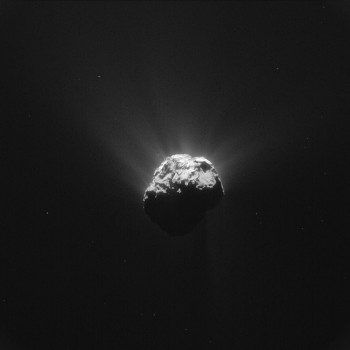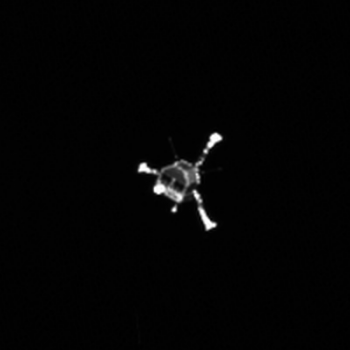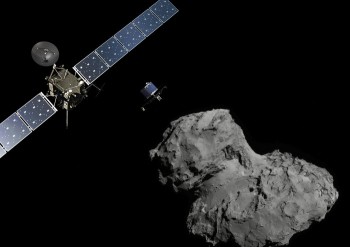The receipt of signals from Rosetta’s Philae lander on 13 June after 211 days of hibernation marked the start of intense activity. In coordination with its mission partners, ESA teams are working to juggle Rosetta’s flight plan to help with renewed lander science investigations.
Philae has woken up after seven months in hibernation on Comet 67P/Churyumov–Gerasimenko. Hidden by shadows, Philae shut down on 15 November 2014 at 00:36 GMT after completing its main science operations sequence on the comet when the primary battery expired as expected after about 60 hours.

This image was taken by Rosetta’s NavCam at 19:38 GMT on 13 June 2015, shortly before Philae’s wake-up signal was received. The signals were relayed by the Rosetta orbiter and received at ESA’s European Space Operations Centre in Darmstadt at 20:28 GMT.
The image was taken from a distance of 201 km from the centre of Comet 67P/Churyumov–Gerasimenko and measures 17.5 km across. The image scale is 17.1 m/pixel. The comet is orientated with the small lobe towards the right, with the large depression known as Hatmehit visible. Philae is thought to be resting just outside the rim, towards the top right in this image.
Credits: ESA/Rosetta/NavCam – CC BY-SA IGO 3.0
Since March 2015, when Philae’s environmental conditions started to improve with higher surface temperatures and better illumination, the orbiter’s receiver had been turned on periodically to listen for signals from the lander when the orbital geometry was thought to be optimum.
On the evening of 13 June, a weak but solid radio link between Rosetta and the lander was finally established for 85 seconds. More than 300 ‘packets’ – 663 kbits – of lander housekeeping telemetry were received. This information had been stored on board at an as-yet-to-be determined time in the past, as much as several days to a few weeks, so does not necessarily reflect the lander’s current status.
Rosetta then relayed the signal to ESA’s European Space Operations Centre, ESOC, in Darmstadt, Germany, at 20:28 GMT.
“We are still examining the housekeeping information at the Lander Control Centre in the DLR German Aerospace Center’s establishment in Cologne, but we can already tell that all lander subsystems are working nominally, with no apparent degradation after more than half a year hiding out on the comet’s frozen surface,” says DLR’s Stephan Ulamec, Philae Lander Project Manager.
A second, smaller burst of lander data was received on Sunday, 14 June, at about 21:26 GMT, lasting just a few seconds. These data were confirmed to give the current status, showing the lander’s internal temperature had already risen to –5ºC.
Philae’s memory has stored over 8000 packets of additional status data, but it is unclear from when in recent days they were recorded.

This image from Rosetta’s OSIRIS narrow-angle camera shows the Philae lander at 10:23 GMT (onboard spacecraft time) on 12 November, almost two hours after separation.
Credits: ESA/Rosetta/MPS for OSIRIS Team MPS/UPD/LAM/IAA/SSO/INTA/UPM/DASP/IDA
Here comes the Sun
Engineers at the Lander Control Centre have determined that Philae is already being exposed to sufficient sunlight to heat it to an acceptable operating temperature and to generate electricity.
“Power levels increase during the local ‘comet day’ – the part of the about-12 hour comet rotation when Philae is in sunlight – from 13 W at comet sunrise to above 24 W,” notes ESA’s Patrick Martin, Rosetta Mission Manager. “It needs at least 19 W to switch on the transmitter.”
The telemetry downloaded covered the lander’s status for a full night–day cycle of the comet, which is helping ground teams to understand how the Sun is shining on the lander. The solar panels appear to be receiving power for over 135 minutes in each illumination period.
“While the information we have is very preliminary, it appears that the lander is in as good a condition as we could have hoped,” says Dr Ulamec.
The task at hand
The main task now for all the mission partners – ESA for Rosetta operations and DLR and France’s CNES space agency for lander operations and science, respectively – is to determine how to optimise Rosetta’s orbit so as to facilitate contact and enable new science investigations.
It is believed that there is sufficient power now being generated to allow some science measurements during the time Philae is illuminated, with initial activities focusing on low-power measurements. This first phase would also likely include measurements that did not previously generate science in November.
However, the mission teams first must establish a more robust link between Rosetta and Philae before uploading the first batch of science operations commands.
The quality of the communication link is also possibly related to the trajectory Rosetta is flying and the orientation it adopts.

Artist impression of Rosetta and Philae at Comet 67P/C-G (not to scale). Credits: ESA/ATG medialab; Comet image: ESA/Rosetta/Navcam
Optimising an orbit 305 million km away
Currently, Rosetta experiences two possible communication slots per 24 hours – once per 12-hour comet rotation.
Until 23:35 GMT on Tuesday, 16 June, Rosetta will be flying an orbit set by already-uploaded commands on the terminator – the plane between comet day and night – moving out from about 200 km to 235 km altitude.
This orbit is not optimised for lander communication, so longer periods of contact may not be possible until the trajectory has been changed.
“With work done by the flight dynamics and operations team at ESOC and based on intense planning being conducted with the mission partners today, a new orbit will be devised that ensures optimum lander communications beginning with the next command upload later tonight,” says Paolo Ferri, ESA’s Head of Mission Operations.
This new orbit will include an already-planned reduction of distance from the nucleus, down to 180 km versus 200 km, and ‘nadir pointing’ – continuously pointing Rosetta’s communications unit at the comet. In the coming days, the orbiter may also be moved closer to the comet, without compromising the safety of the spacecraft, to help communications.
The new orbit will be flown by Rosetta starting after 23:25 GMT on 16 June until 19 June, aiming to enable more and longer contacts with Philae, especially towards the end of this period.
Ready to react quickly
Establishing a regular and predictable pattern of contacts is a prerequisite for performing a complete assessment of the lander’s status and for planning science operations.
“If we manage to achieve and maintain a predictable contact pattern,” continues Paolo Ferri, “the lander teams can devise a strategy for a new sequence of scientific operations.
“Regardless, we will stay very flexible and be ready to react quickly. It’s clear this incredible mission continues to stimulate and challenge us, developing in ways we could never have predicted.”
As a bonus, any operation of Philae’s instruments up to or through perihelion on 13 August – the comet’s closest point to the Sun along its orbit – will allow in-situ study of a comet during its peak activity.
Had Philae landed at the planned site, at Agilkia in November 2014, its mission would likely have ended in March because of the higher temperatures of that location as solar illumination increased.
Rosetta is an ESA mission with contributions from its Member States and NASA. Rosetta’s Philae lander is contributed by a consortium led by DLR, MPS, CNES and ASI.









Discussion: 28 comments
Congratulations!
-5°C is exciting. I think no one has been expecting this high temperature and the extended daily solar illumination, but well below the upper temperature limit. So there might be an un-anticipated chance to load the rechargeable, and to get close to the initially planned long term science sequences.
And this all at a location better than hoped, during maximum activity.
Now hopefully the science operations will work well. An unprecedented opportunity beyond expectations!
Gerald: Is it -35 C at evening/night when it communicated and -5 C with better daylight? Should know what it becomes at local noon to guess how hot it will get at perihelion.
Those temperatures refer to the thermally insulated interior of Philae, not the outside.
As far as I understood, these have been single measurements which have not yet been associated to a chronology.
With still some uncertainty (since some optimization commands have been sent blindly) Philae should have used as much of the solar power as possible for heating to get above the temperature where it can boot the computers, -45° to -40°C. The next priority has then been to reach the 19 W limit for sending to Rosetta.
At perihelion Philae won’t need as much energy for heating its interior. I don’t think, that overheating is a risk.
It would have terminated activities in March with 6 hours solar illumination. But now we are probably at 2 to 3 hours. I’d think this should work through perihelion.
The other question is, how close Rosetta will be able to operate near the comet during perihelion. At some distance, communication will get difficult.
Initially an operative Philae hasn’t been forseen during perihelion. So the whole Rosetta activities need to be adjusted.
The team has been very busy all the past months. But now I don’t think, there is really much time left for talks or explanations to the public, in times of high public attention.
Has the area where Philae landed been given a formal name yet? When the “public” maps were posted here on The Blog that area was not well-illuminated and shown on the maps. As far as I can tell, it is South of the major depression Hatmehit and between the area Bastet (on the east) and the area Maftet (on the west). I _think_ that part of the CONSERT ellipse is in “western Bastet” and part of it is in the (unnamed) region to the west.
I’m going through many archive Navcams to find imagery of that region, but many of these images have low lighting angles, which is fine for dramatic effect but hard to work with.
–Bill
Bill: Isn’t it Abydos? Where it is exactly we don’t know yet.
Interesting to see that the suspected site is nearly at the terminator and Rosetta is directly at the zenith above the terminator. Is this because of Philae’s inclination with respect to the ground? Or perhaps by going to zenithal position closer to local noon Rosetta might get a better communication window.
The suspected site is not at the terminator (any more) it should be described as a little south of the equator. Equinox was in May, so the sun would be almost directly “overhead” at “noon” Abydos time. Thus, sun side triangular orbits are probably indicated rather than terminator at the moment. The terminator is moving from the North to the South.
Thanks for this exiting news. And I hope there will be more news Sion!
Is there room to improve Philae’s sun exposure? If I remember correctly you sent some instructions before hibernation to try to do so. Have they been successful?
I remember reading, before the landing, that the environment would become too hot for Philae as the comet approached perihelion.
Is it now hoped that the shaded position will help keep Philae cool?
Sorry! – I’ve now read the last sentence.
What a silver lining!
Congratulations to everyone involved in this mission.
Muitos parabéns! Será agora possível alguma alteração da posição da Philae, de modo a permitir maiores ganhos de energia?
Congratulations on Philae’s awakening!
I cheered when I heard the news, and am happy for every one of you who have worked so hard on this mission.
I am particularly glad that the harpoon malfunction and Philae’s “jump-hop-skip-hide” may actually result in the potential for the Team to do science near perihelion you had no expectation you would be in a position to do!
Do we have any more precise idea about Philae’s location; or any means of narrowing that down?
Wish this strategy of trying to make the link between Rosetta & Philae stable and longer works!
And thank you to all of you who are trying to share with public what is happening to the mission as soon as possible these days!! Hope all of you have time to sleep and stay healthy. Like Philae!!
One question I have is: Getting closer to Philae cannot be a disadvantage for longer communication time?? This lower “orbit” still gives Rosetta long enough time of radio link with Philae?? Does the team think about keeping Rosetta stay over Philae’s horizon by using thrusters??!!
Anyway minus 5 celsius is unbelievable!! I saw an article at somewhere else in which Dr Ulamec said with this temperature Philae can recharge the battery. I think this must be stable for at least 4 months (correct??) from now on unless 67P does not move Philae or does not make the sky above Philae too “cloudy” by whatever. Hope it gets to enough level to bring SD2 into spotlights again! It’s so exciting!! To be honest I even started worrying if there’s really no need to worry about overheating!!
Hope Philae can start doing science before long! Best of luck to Rosetta/Philae mission!!
Rosetta is moving very slowly in her orbit. about 2 Kilometers per hour. At 200 km distance this makes almost no difference at all. The comets spin is what makes for most of the relative movement.
But going closer increases the signal strength. (remember radio falls of with the square of the distance)
Rosetta is currently north of the equator and they will probably move her south to get a better link aswell.
They know what to do. 🙂
What a news!
Hopefully, the team can get more pictures from the lander soon…
Is there an explanation for such high temperature? Does Philae generate its own heat, or is -5°C what should be expected on a comet that is as far from Sun as Mars is?
I believe that some key electronics are kept in a heated chamber inside Philae – I don’t think that -5C is the ‘outside’ surface temperature (though could be wrong).
My understanding is that Philae uses the energy received from the sun and has to heat itself up from that. I don’t think it is the ambient comet temperature, which I expect is much lower than -5C. Happy for someone to put me right on that.
Hi there,
Spacecraft thermal engineer here.
You are correct, there is a difference (huge) between environment temperature and internal spacecraft temperature. I am not working on Philae but the -5°C is probably a temperature reading of an internal sensor to Philae (best guess is it is the sensor on the battery).
As a reminder, deep space = -269°C, surface temperature is between -70°C and +70°C pending illumination and proximity to the sun, the electronics are able to work around -35°C (cold start up), the ideal battery temperature is between -10°C/+10°C.
There are three contributors when it comes to heating philae:
– the heat generated by the electronics themselves
– the solar heat fluxes
– some heaters are installed on key components (pending on their lower qualification temperatures)
There are contributors when it comes to cooling philae:
– view factor to deep space (radiative exchanges)
– view factor to the surrounding environment, its emissivity and its temperature (radiative exchanges)
– conductive leaks (feet touching the surface)
Keep in mind that the thermal design includes insulation blankets (to keep the heat inside and to protect from excessive heat inputs/leaks from the harsh environment).
Also keep in mind that the temperatures on Philae are not uniform: there are lots of gradients.
Good point gshegosh. The comet is crossing the orbit of Mars right at this time at a distance of approx 228 million kilometres from the Sun. The average surface temperature of Mars is around -60 deg C. How does the lander achieve an internal temperature 55 deg higher. A waste of precious power if it is internal heat. Perhaps there is another external source, in addition to solar radiation. Odd too because with all the high pressure ice vapour jetting out as hypothesised it would be expected that heat would be extracted from the nucleus surface and anything on it. You know, the way ice forms near the nozzle opening of a high pressure gas jet when there is any water vapour around, as Joule and Thompson noted.
I’m not sure what the “average” temperature at Mars has to do with things. It is a large, spherical body, with an albedo of 29%. The temperature to note, which has any relevance, is the warmest temperature at the places experiencing overhead sunlight. That is about 20C. Temperatures on both bodies will drop off steeply with height above the surface due to low to non-existent atmospheres.
Can the communication links be used to “triangulate” Philae and get a certain location?
“Kamal Lodaya says:
16/06/2015 at 06:30
Bill: Isn’t it Abydos? Where it is exactly we don’t know yet. ”
Ah, that’s right: ABYDOS– slipped my mind. I was somewhat amused by that since it was a key location in the Sci-Fi television series Stargate-SG1. Poor little Philae came very close to going “over the edge” and ending up in the cold-long-Winter South Polar region.
HINT Hint– we need a nice high-res OSIRIS image of that region.
And here is to a lot of good science from Philae…
–Bill
Justin, to triangulate you would need a minimum of three points.
What if we have records of trajectory of Rosseta while it was having robust connection with Philae in November 2014. Since Philae is at same location and if we place Rosseta at same trajectory there are chances we have robust link with Philae.
Why no news?
Has there been no further contact with Philae? Has the repositioning worked or not? tell us something!